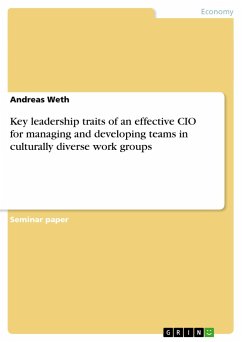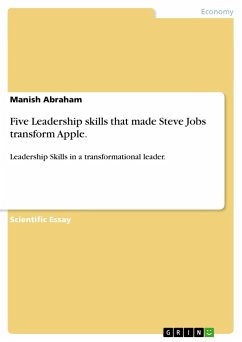
Key leadership traits of an effective CIO for managing and developing teams in culturally diverse work groups

PAYBACK Punkte
0 °P sammeln!
Seminar paper from the year 2005 in the subject Business economics - Business Management, Corporate Governance, grade: A (1,3), University of Auckland (Facultiy of Computing), language: English, abstract: In these days, leadership seems to be a critically researched topic. Morse (2004) discusses executive psychopaths and Maccoby (2004) analyses problems with narcissistic leaders. According to them, there is a high quota of unsuccessful leaders (Morse, 2004 & Maccoby, 2004) and therefore it is getting more and more important to identify and validate key leadership traits before employing leader...
Seminar paper from the year 2005 in the subject Business economics - Business Management, Corporate Governance, grade: A (1,3), University of Auckland (Facultiy of Computing), language: English, abstract: In these days, leadership seems to be a critically researched topic. Morse (2004) discusses executive psychopaths and Maccoby (2004) analyses problems with narcissistic leaders. According to them, there is a high quota of unsuccessful leaders (Morse, 2004 & Maccoby, 2004) and therefore it is getting more and more important to identify and validate key leadership traits before employing leaders to avoid costly top level management debacles. Especially an unsuccessful CIO can be very expensive for a company due to high business risks which result from the use of information technology (think about the huge risks companies are facing when they are implementing an ERP solution in a multimillion dollar project). With increasing pressure, the CIO (who is in my interpretation in the graphic on page two the tiny manager in front of the desk who is trying to look up to the CEO) is in a difficult position. Being supervised by the CEO (displayed in the picture on page too as the manager behind the desk whose view seems to be clouded), he has to manage culturally diverse teams in the complex and changing business and IT environment. His function is to coordinate IT as a tool to support business functions and value adding processes, in the context of Porter's value chain. (Porter, 1998) This leads to the need for the CIO to understand and integrate two aspects: the business side and the IT related aspects. The problem is that in most cases, even the CIO is not able to understand every detailed aspect of information technology and of the conducted business. Therefore he has to manage with a lack of information and lead a team consisting of different and often culturally diverse specialists. This essay analyses and describes traits of an effective CIO with the use of current leadership literature, in particular with references to the work from Warren Bennis, Abraham Zaleznik and Daniel Goleman. Identified traits and significant findings are highlighted (bold) to give to focus the reader on the most important aspects.













